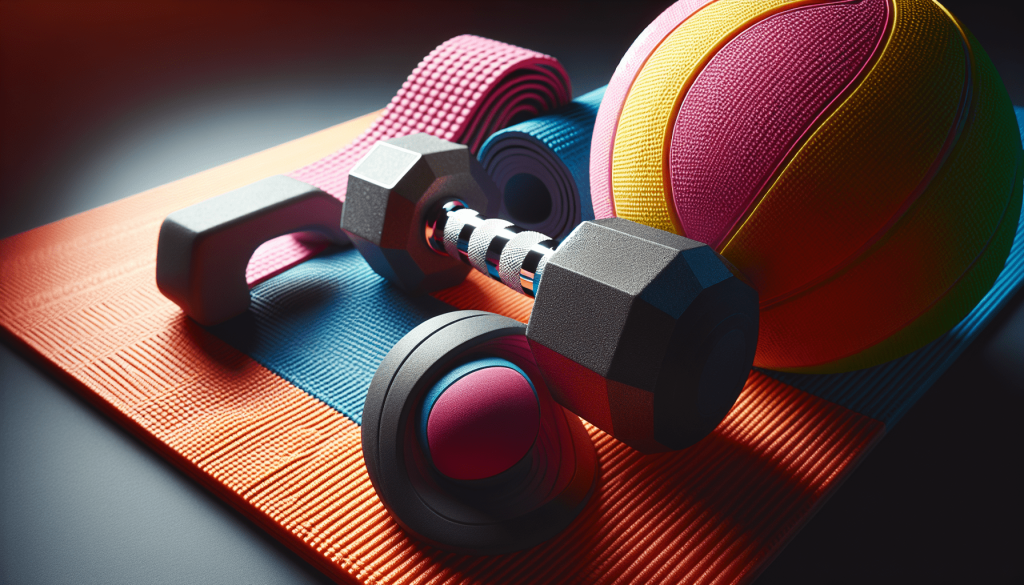Are you looking to build six-pack abs and strengthen your core muscles? If so, you may be wondering how to effectively target the oblique muscles for a well-rounded ab workout. These muscles, located on the sides of your abdomen, play a crucial role in stabilizing your torso and enhancing your overall athletic performance. In this article, we will explore various exercises and techniques that can help you specifically target and develop your oblique muscles, ultimately leading to a more sculpted and defined midsection. Whether you’re a fitness enthusiast or just starting your fitness journey, this article will provide you with valuable insights and tips to achieve your desired results.
Understanding the Oblique Muscles
What are the oblique muscles?
The oblique muscles, also known as the obliques, are a group of muscles located on the sides of your abdomen. There are two sets of oblique muscles – the external obliques and the internal obliques. The external obliques are the outermost muscles and run diagonally downward from your ribs to your pelvis. The internal obliques lie underneath the external obliques and run diagonally upward from your pelvis to your ribs. These muscles play a crucial role in various movements such as twisting, bending, and stabilizing the trunk.
How are the oblique muscles important for a well-rounded ab workout?
When it comes to achieving a well-rounded ab workout, targeting the oblique muscles is essential. These muscles not only contribute to the aesthetics of a defined waistline but also play a vital role in core strength and stability. By strengthening your obliques, you enhance your ability to perform functional movements, improve posture, and reduce the risk of injury during sports and everyday activities. Additionally, well-developed obliques can help support your lower back, improve rotational power, and enhance overall athletic performance.
Exercises Targeting the Oblique Muscles
Russian Twists
Russian twists are a compound exercise that primarily targets the oblique muscles. To perform this exercise, sit on the ground and elevate your feet slightly off the floor. Hold a weight or medicine ball in front of your torso and twist your upper body from side to side, touching the weight to the ground on each side. This exercise engages both the external and internal obliques and can be modified to increase or decrease the difficulty level based on your fitness level and equipment availability.
Side Planks
Side planks are an effective exercise for targeting the oblique muscles, along with the entire core. Begin by lying on your side, supported by either your forearm or a straight arm. Lift your hips off the ground, creating a straight line from your head to your feet. Hold this position for a set amount of time and then switch sides. Side planks activate the obliques by engaging the muscles on the side of your body that is supporting the weight.
Bicycle Crunches
Bicycle crunches are a classic exercise that engages the obliques while also targeting the rectus abdominis (the “six-pack” muscles). Start by lying on your back with your hands behind your head and your knees bent. Lift your feet off the ground, and while simultaneously bringing your right elbow to your left knee, extend your right leg straight. Repeat on the opposite side, mimicking a bicycle pedaling motion. By incorporating the twisting motion, bicycle crunches effectively target the oblique muscles.
Woodchoppers
Woodchoppers, also known as standing oblique crunches, provide an effective way to work the oblique muscles dynamically. Begin by standing with your feet shoulder-width apart and hold a weight or medicine ball with both hands. Start with the weight at one side of your body near your hip. As you raise the weight diagonally across your body, pivot on your opposite foot and twist your torso. Repeat the movement on the other side. Woodchoppers mimic the movement of swinging an ax, hence the name, and engage the obliques through rotation and stabilization.
Side Bends
Side bends specifically target the external obliques, helping to strengthen and define your waistline. Stand with your feet shoulder-width apart and hold a dumbbell or weight plate in one hand. With your opposite hand resting on your hip, lean to the side while keeping your core engaged and your back straight. Return to the starting position and repeat on the other side. Side bends can be performed with different variations, such as using a cable machine or resistance band, to provide a challenge and effectively work the oblique muscles.

Proper Form and Technique
Importance of maintaining proper form during oblique exercises
Maintaining proper form during oblique exercises is crucial for both targeting the right muscles and minimizing the risk of injury. When performing these exercises, focus on maintaining a neutral spine, engaging your core muscles, and avoiding excessive twisting or bending at the spine. Keep your movements controlled and deliberate, avoiding any jerky or swinging motions. By paying attention to your form, you ensure that the oblique muscles are effectively targeted, leading to better results and reduced strain on other parts of your body.
Tips for correct technique to effectively target oblique muscles
To effectively target the oblique muscles, there are some key technique tips to keep in mind. First, breathe consistently throughout each exercise, exhaling during the most challenging part of the movement. This helps engage the deep core muscles and stabilize the spine. Second, focus on pulling your belly button in towards your spine to activate the transverse abdominis, which helps stabilize the trunk. Finally, concentrate on the mind-muscle connection, visualizing the oblique muscles contracting and releasing with each repetition. These technique tips will help you maximize the effectiveness of your oblique exercises.
Frequency and Repetitions
Recommended frequency of oblique exercises
For optimal results, it is recommended to incorporate oblique exercises into your workout routine 2-3 times per week. This frequency allows enough time for muscle recovery while providing sufficient stimulus for growth and strength development. It is important to note that the obliques are endurance muscles, meaning they are resistant to fatigue and can handle higher repetitions compared to other muscle groups. Therefore, targeting the obliques with higher repetitions and moderate intensity is key.
Number of repetitions and sets for optimal results
To effectively target the oblique muscles, aim to perform each exercise for 12-15 repetitions per set. Complete 2-3 sets of each exercise, allowing 30-60 seconds of rest between sets. The number of repetitions and sets can be adjusted based on your fitness level and goals. Remember, it is essential to maintain proper form and execute each repetition with control. Do not compromise form for the sake of increasing repetition numbers. Gradually increase resistance or difficulty as you gain strength and endurance.

Incorporating Oblique Exercises into a Routine
Best time to include oblique exercises in a workout
The best time to include oblique exercises in your workout depends on your overall routine and personal preference. However, it is generally recommended to perform oblique exercises after your primary compound movements, such as squats or deadlifts. By targeting the oblique muscles towards the end of your workout, you avoid pre-fatiguing them and potentially compromising your form during exercises that require core stability. Additionally, this sequencing ensures that your obliques receive proper attention and effort, leading to better results.
Combining oblique exercises with other ab workouts
While oblique exercises primarily focus on the sides of your abdomen, it is important to incorporate other ab workouts for a well-rounded core routine. Exercises such as planks, crunches, and leg raises target different parts of the abdominal muscles, including the rectus abdominis and transverse abdominis. By combining oblique exercises with other ab workouts, you can ensure that all areas of your core are adequately strengthened and balanced. Remember to vary your exercises to avoid muscle adaptation and continue challenging your abdominal muscles.
Creating a balanced routine targeting oblique muscles
To create a balanced routine targeting the oblique muscles, consider incorporating a variety of exercises that not only focus on the obliques but also engage the entire core. Start with compound movements like squats, deadlifts, or overhead presses to engage the core as a stabilizer. Follow this with specific exercises targeting the oblique muscles, such as Russian twists, side planks, and woodchoppers. Finish your routine with exercises that engage the other abdominal muscles, such as crunches and leg raises. This comprehensive approach ensures balanced development and strength throughout your core.
Variations and Progressions
Advanced oblique exercises for increased intensity
As you gain strength and endurance in your oblique muscles, it is important to incorporate advanced exercises to continue challenging yourself. Some advanced oblique exercises include:
- Windshield Wipers: Hang from a pull-up bar, keeping your legs straight. Slowly rotate your legs from side to side, mimicking the motion of windshield wipers.
- Dragon Flag: Lie on a bench or the ground, holding onto the bench behind your head. Raise your body off the ground, keeping it straight, and lower it back down slowly.
- Side Plank with Leg Raise: From a side plank position, lift your top leg and hold it in line with your body. Lower it back down and repeat on the other side.
These exercises require a high level of strength and control, so ensure that you have mastered the foundational exercises before attempting these advanced variations.
Incorporating variations to target different parts of the oblique muscles
To target different parts of the oblique muscles, you can incorporate variations into your routine. For example, performing side planks with rotations or adding a resistance band to your Russian twists can engage specific areas of the obliques. You can also adjust your body position during side bends by leaning forward or backward to target different areas of the external obliques. By incorporating variations into your routine, you not only keep your workouts exciting but also ensure that all parts of your oblique muscles are effectively targeted.

Common Mistakes to Avoid
Mistakes that hinder effectiveness of oblique exercises
To ensure the effectiveness of your oblique exercises, it is crucial to avoid these common mistakes:
- Using momentum: Swinging or jerking during exercises reduces the workload on the obliques and decreases their activation.
- Neglecting proper form: Allowing your spine to round or arch excessively can put strain on your lower back and limit the recruitment of the oblique muscles.
- Holding your breath: Forgetting to breathe or holding your breath during exercises decreases core stability and can limit your overall performance.
By avoiding these mistakes and focusing on proper form, you maximize the effectiveness of your oblique exercises and minimize the risk of injury.
Tips to avoid injury and maximize results
To avoid injury and maximize results during oblique exercises, keep these tips in mind:
- Start with light weights or bodyweight exercises if you are a beginner and gradually increase intensity or resistance as your strength improves.
- Listen to your body and avoid pushing through pain. If you experience discomfort or sharp pain, stop the exercise and consult a healthcare professional.
- Warm up before your workout to increase blood flow and prepare your muscles for the movements.
- Include rest days in your routine to allow for proper recovery and muscle growth.
- Focus on quality over quantity. Performing exercises with proper form and control yields better results than rushing through repetitions.
By following these tips, you can minimize the risk of injury and optimize your oblique workouts.
Stretching and Recovery
Importance of stretching oblique muscles
Stretching your oblique muscles is essential to enhance flexibility, prevent muscle imbalances, and reduce the risk of injury. Tight oblique muscles can limit your range of motion during exercises and activities, leading to compensation patterns and strain on other muscles. Proper stretching can help elongate the oblique muscles, increase their flexibility, and improve overall movement quality.
Recommended stretches for the obliques
Here are two effective stretches for the obliques:
- Standing Side Stretch: Stand with your feet hip-width apart and raise one arm overhead. Bend sideways towards the opposite side, feeling a stretch along the side of your body. Hold the stretch for 20-30 seconds on each side.
- Seated Torso Twist: Sit on the ground with your legs extended in front of you. Twist your torso to one side and place the opposite hand on the outside of your thigh. Gently twist further while looking over your shoulder. Hold the stretch for 20-30 seconds on each side.
Perform these stretches after your workout or as part of your warm-up routine to promote flexibility and prevent muscle tightness.
Recovery techniques to prevent muscle soreness
To prevent muscle soreness and aid in recovery after oblique workouts, consider incorporating these recovery techniques:
- Foam rolling: Use a foam roller to roll over the sides of your abdomen, targeting the oblique muscles. This helps release tension and improve blood flow.
- Active recovery: Engage in light cardio exercises or gentle stretching on rest days to promote circulation and facilitate muscle recovery.
- Proper nutrition: Consume a balanced diet rich in protein, carbohydrates, and healthy fats to provide the necessary nutrients for muscle repair and recovery.
- Rest and sleep: Allow your body ample time to rest and recover by prioritizing quality sleep and incorporating rest days into your weekly routine.
By implementing these recovery techniques, you can minimize muscle soreness and promote optimal muscle growth and repair.

Nutrition for Strong Abdominal Muscles
Eating a balanced diet for muscle development
Nutrition plays a crucial role in building strong abdominal muscles. To support muscle development, it is important to consume a balanced diet consisting of lean protein, complex carbohydrates, healthy fats, and an adequate intake of vitamins and minerals. Protein is particularly important for muscle repair and growth, so include sources such as lean meats, poultry, fish, eggs, legumes, and dairy products. Carbohydrates provide energy for workouts, while healthy fats aid in hormone production and overall health. Aim to include a variety of fruits, vegetables, whole grains, and nuts in your diet to ensure a well-rounded nutrient intake.
Foods that can support abdominal muscle growth
Certain foods can support abdominal muscle growth and help you achieve your fitness goals. Consider incorporating the following foods into your diet:
- Greek yogurt: High in protein and calcium, Greek yogurt is a versatile food that can be enjoyed on its own or as an ingredient in smoothies or healthy desserts.
- Salmon: Rich in omega-3 fatty acids and high-quality protein, salmon provides essential nutrients for muscle growth and overall health.
- Quinoa: A nutrient-dense grain, quinoa is a great source of carbohydrates, protein, and fiber, making it ideal for post-workout meals.
- Avocado: Packed with healthy monounsaturated fats, avocados provide a sustainable source of energy and support muscle recovery.
- Spinach: This leafy green vegetable is rich in vitamins, minerals, and antioxidants, supporting overall muscle function and health.
Remember to maintain portion control and balance your macronutrient intake based on your specific dietary needs and fitness goals.
Hydration and its impact on muscle performance
Staying hydrated is crucial for optimal muscle performance, including the obliques. Water is essential for transporting nutrients to the muscles, regulating body temperature, and maintaining overall bodily functions. During workouts, dehydration can lead to decreased endurance, muscle cramps, and fatigue. Aim to drink water before, during, and after your workouts to ensure adequate hydration. The exact amount of water needed varies depending on factors such as body weight, activity level, and environmental conditions. Listen to your body’s thirst cues and pay attention to the color of your urine as a general gauge of hydration levels.
Monitoring Progress and Adjustments
Tracking and measuring oblique muscle development
Tracking your progress is essential for staying motivated and assessing the effectiveness of your oblique workouts. To monitor oblique muscle development, consider using the following methods:
- Progress photos: Take photos of your obliques from different angles consistently to visually track changes and improvements in muscle tone and definition.
- Circumference measurements: Use a tape measure to monitor changes in your waist circumference over time. Decreased measurements indicate muscle development and fat loss.
- Body composition analysis: Utilize methods such as bioelectrical impedance, DEXA scans, or skinfold calipers to assess your body fat percentage, which can give you a clearer idea of your muscular development.
By regularly tracking and measuring your progress, you can make adjustments to your training routine and nutrition plan as needed to continue making gains.
How to adapt exercises as you gain strength and endurance
As you gain strength and endurance in your oblique muscles, it is important to adjust your exercises to continue challenging yourself and promoting growth. Here are some ways to adapt exercises:
- Increase resistance: Gradually increase the weight or resistance used during exercises such as Russian twists or woodchoppers to continually challenge your muscles.
- Decrease stability: Perform exercises such as side planks on an unstable surface, such as a BOSU ball, to engage more stabilizing muscles and increase the difficulty.
- Incorporate unilateral exercises: Perform side bends or woodchoppers with one side at a time to focus on each oblique individually and increase the demand on the muscles.
- Tempo variations: Experiment with slower and controlled movements, as well as explosive movements, to challenge your oblique muscles differently and stimulate growth.
By constantly adapting and progressing your exercises, you can ensure continued improvement and prevent plateaus in your fitness journey.
Incorporating oblique exercises into your workout routine is essential for a well-rounded ab workout that targets all areas of your core. By understanding the oblique muscles, performing exercises with proper form and technique, and adopting a balanced approach to nutrition and recovery, you can effectively target and develop strong, defined oblique muscles. Keep track of your progress, make necessary adjustments along the way, and remember to listen to your body to maximize results and enjoy the journey towards a stronger, healthier core.






